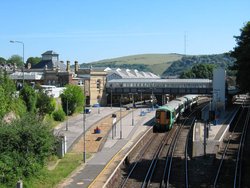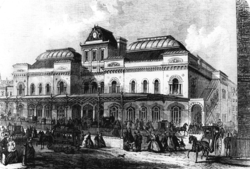Train station
|
|
A train station (American English), or railway station (British English), is a point of call for trains, allowing the loading or unloading of goods, or allowing passengers to board and alight. Early stations were usually built with both passenger and goods facilities. This dual purpose is less common today, and in many cases goods facilities are restricted to major stations. Generally stations are sited next to a railway or railroad line, or form the terminus for a particular route. Usually platforms are present to allow passengers to access trains easily and safely. Platforms may be connected by subways, bridges, or level crossings to the main part of the station; passenger facilities such as shelter, ticket sales, waiting rooms and benches are partly there, partly on the platforms.
| Operations |
| Stations |
| Trains |
| Locomotives |
| Rolling stock |
| History |
| Terminology |
| By country |
| Disasters |
| Modelling |
| edit this box (https://academickids.com:443/encyclopedia/index.php?title=Template:Train_topics&action=edit) |
As well as providing services for passengers and loading facilities for goods, stations often had locomotive and rolling stock depots (including refuelling, sidings and sheds). A train station that is jointly used by several rail transport companies is sometimes called a union station, or an interchange station. Train stations colocated with other transport systems such as trams and buses may also be referred to as interchanges, as may stations offering both metro/subway and heavy rail services.
| Contents |
Development
KyotoStation.jpg
The first train stations resembled tram stops, with little in the way of buildings or facilities. Although the Stockton and Darlington Railway was the first railway, it carried freight only. So the first railway stations in the modern sense were on the Liverpool and Manchester Railway, opened in 1830. Today Liverpool Road station is preserved as part of the Museum of Science and Industry in Manchester. It resembles a row of Georgian houses [1] (http://www.msim.org.uk/galleries.asp?main=010400).
Many train stations — unsurprisingly — date from the 19th century and reflect the architecture of the time, grand in scale and size, lending prestige to the city as well as to railway operations. They also reflect the hubris of the time. Other countries, where railways arrived later, may still have such architecture, as later stations often imitated 19th century styles. Various forms of architecture have been used in the construction of railway stations, from those boasting grand and intricate almost baroque-style edifices, to more stark utilitarian or modern styles. Stations built more recently often have a similar feel to airports, with a cold and plain abstract style.
Examples of modern stations include those on newer high-speed rail networks, such as the shinkansen in Japan and LGV lines in France. Britain boasts a new modern rail terminus at Waterloo International, the end-point for the Eurostar Channel Tunnel rail services to France and Belgium. This station will cease to be the Eurostar terminal when the new St Pancras terminal, connected to the Channel Tunnel high-speed rail link, opens in 2007.
Superlatives
The world's busiest train station, in terms of daily passenger throughput, is Shinjuku Station in Tokyo, Japan. Ikebukuro Station, just minutes away, is the world's second-busiest. By train throughput, the world's busiest train station is Clapham Junction in London.
The world's largest train station, in terms of floor area, is Nagoya Station in Nagoya, Japan. However, the Nagoya Station complex incorporates two office towers and an underground shopping concourse, so the railway terminal itself is not large in comparison to others. Shinjuku Station is the second largest. In terms of platform capacity, the world's largest train station is Grand Central Terminal in New York City, USA.
Terminal stations
Main article: terminal station
A terminus is a station sited where a railway line ends or terminates. Thus, platforms can be reached without crossing tracks.
Often a terminus is the final destination of a train, but not necessarily. When a train is required to travel onwards from a terminus, it must reverse out of the station to continue the trip. Various methods exist to counter this problem.
The same applies if the station is not a terminus, but the train service involves reversing direction anyway.
Reversing direction often causes some worry to travellers who are inexperienced and have no detailed geographic knowledge of the railway lines — one might assume the train has finished its journey and is returning to the starting location. Some travellers prefer facing forward; if possible they change place when there is a reversal of direction. In some types of carriages, train personnel are able to turn the seats when the train changes direction so that all travellers face forward.
For more on this, see Commuter train.
Station facilities
Train stations usually include either ticket booths, or ticket machines. Ticket sales may also be combined with customer service desks or convenience stores. Many stations include some form of convenience store. Larger stations usually have fast-food or restaurant facilities. In some countries, such stations also have a bar, or pub. Other station facilities include: toilets, left-luggage, lost-and-found, departures and arrivals boards, luggage carts, waiting rooms, taxi ranks and bus bays. Larger or manned stations tend to have a greater range of facilities. A most basic station might only have platforms, though it would still be distinguished from a halt, a stopping or halting place that may not even have platforms.
Configurations of train station

In addition to the basic configuration of a train station, various features set certain types of station apart. The first is elevation. While most stations are at ground level, those in cities or urban areas are often elevated or situated below ground, even if the station is not necessarily part of an underground metro system. The reason is usually to grade-separate road systems. Elevated stations are more common, not including metro stations.
Another unusual configuration is where the station serves railway lines at differing levels. This may be due to the station's situation at a point where two lines cross, or may be to provide separate station capacity for two types of service, e.g. intercity and suburban, or simply two different destinations.
Some stations have unusual platform layouts, due to space constraints of the station location, or the alignment of the railway lines. Examples are non-parallel platforms and curved stations (and platforms).
A list is available detailing further examples of less usual railway station layouts.
Accessibility
Accessibility for people with disabilities is important in train station design and mandated by law in some countries. Considerations include: elevator or ramp access to all platforms, matching platform height to train floors, making wheelchair lifts available when platforms do not match vehicle floors, accessible toilets and pay phones, audible station announcements, safety measures such as tactile marking of platform edges and covering of third rail.
See also
Template:Pic List of railway stations, List of IATA-indexed train stations, Signal box, Transport, hump yard, Public transport, Metro station, Bus stop.de:Bahnhof es:Estación ferroviaria fr:Gare it:Stazione ferroviaria nl:Spoorwegstation ja:鉄道駅 pl:Dworzec kolejowy ro:Gară ru:Железнодорожная станция sl:Železniška postaja fi:Rautatieasema zh:鐵路車站


